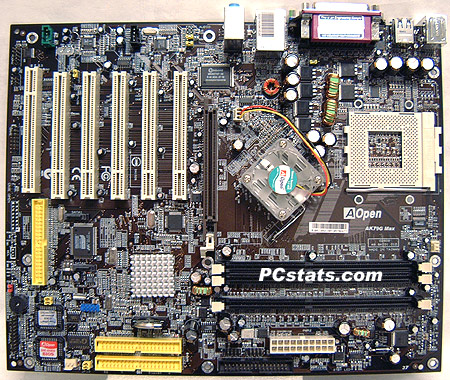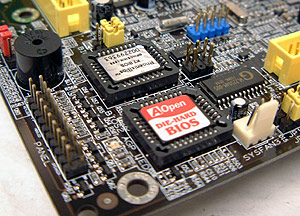AOpen AK79G MAX nForce2-GT Motherboard Review
AOpen are
one of the larger component manufacturers in the industry, also producing a
vast array of peripherals like keyboards and even computer cases. Such
is the diversity of products that it would not be a stretch to
say you could just about assemble an entire computer from purely AOpen parts, even
down to the very last stick of RAM. Aiming
for the mass markets generally means you get good value with AOpen products,
and one such example of this is the AK79G Max nForce2-GT (Crush 18G) motherboard
we are examining here which is priced at about $140USD.
Nvidia
have recently expanded on the nForce2 lineup which
originally encompassed just the nForce2-G/nForce-S Northbridges, and MCP Southbridge. The two new iterations
to be added to the family include the nForce2-GT and nForce2-ST
which contain the MCP-T Southbridge.
The AK79G Max uses the nForce2-GT chipset, and the main difference between
this and the original nForce2-G are the inclusion of
IEEE 1394 Firewire, TV-out options, networking hardware nVidia have entitled 'DualNet' (basically describes
nvidia and/or 3Com hardware controllers for 10/100 Ethernet) and use of
nVidia's Audio Processing Unit (APU).
The most
interesting of these differences is probably the nVidia APU since onboard sound
quality is usually a big issue with consumers, especially gamers who connect
their PC's to a stereo. Nvidia's Audio Processing Unit is paired
up alongside a Realtek ALC650 AC'97 codec chip and is capable of delivering a wide range of advanced audio features
under the marketing-friendly name "SoundStorm."
There are currently a
small handful of approved hardware-based AC'97 codec chip
manufacturers which can be used with nForce2 systems; including companies
such as Realtek, Sigmatel and C-Media. We've frowned on AC'97 in the past when
it has been implemented as a software codec (as with many VIA chipsets), or when
the hardware codec (chip) was coupled in such a way as the main
processor acts as the digital controller. If you're lost don't worry,
we're going to explain the fine points right now...
The basic situation is
that the AC'97 codec handles the 'headphone circuit' (amplification,
mixing, analog inputs, etc.) and interfaces to physical outputs on the motherboard such
as the headphone or speaker jacks. Another device called the Digital
Signal Processor (DSP), or digital controller handles the digital audio
processing, effects, audio streams and other computational aspects. In the case of
the nForce2-GT, the digital controller, or 'hardware soundcard' as it is also
sometimes referred to is the APU. By aiming for the APU & codec approach on
the Aopen Ak79G Max we have the best of both worlds - each chip handles what it
is best at, and no extraneous load is imparted on the processor. Incidently, this
is the configuration most good standalone PCI soundcards apply;
alongside the DSP which processes the digital audio you'll find a small codec chip.
There is a good explanation of this audio technology here if you are interested in knowing more of the details.
With Soundstorm, there is a wide host
of audio hardware-accelerated effects which we won't go into here (for more info
see nVidia's site) that are intended to put a nail in the
coffin of the sound card business. The big plus with equipping a motherboard
with decent onboard sound is that it can be readily
connected to an amp, or stereo, via a digital S/PDIF RCA or optical cable connection. Soundstorm also allows the system
to make use of Dolby Digital Encoding.
TV-output is another feature
consumers have become accustomed to finding on their videocards as standard
equipment for the last year or so. The nForce2-GT chipset incorporates this
ability to output to a TV, and with the included header you can connect under
NTSC or PAL signals with a standard RCA or S-Video cable. This can come in handy
of you want to output a DVD to a nearby TV for example.
 |
nForce2-GT |
nForce2-G |
nForce2-ST |
nForce2-S |
| Chipset: |
IGP +
MCP-T |
IGP+MCP |
SPP + MCP-T |
SPP+MCP |
|
Front Side Bus (FSB): |
333/266/200
MHz |
333/266/200 MHz |
333/266/200
MHz |
333/266/200
MHz |
|
Intergrated Graphics: |
GeForce4 MX |
GeForce4 MX |
No |
No |
|
AGP Slot: |
AGP3.0 8X/4X
(1.5v) |
AGP3.0 8X/4X
(1.5v) |
AGP3.0 8X/4X
(1.5v) |
AGP3.0 8X/4X
(1.5v) |
|
128-bit Dual Channel: |
DDR400*/333/266/200 |
DDR400*/333/266/200 |
DDR400*/333/266/200 |
DDR400*/333/266/200 |
|
Max Memory Size: |
3GB Max |
3GB Max |
3GB Max |
3GB Max |
|
IDE: |
Integrated ATA133 controller |
Integrated ATA133 controller |
Integrated ATA133 controller |
Integrated ATA133 controller |
|
Firewire: |
Yes |
No |
Yes |
No |
|
Networking: |
dualnet, nvidia networking and/or
3Com networking |
nvidia networking
only |
dualnet, nvidia networking and/or 3Com networking
|
nvidia
networking only |
|
Audio: |
NForce Audio Processing
Unit (APU)
Nvidia SoundStorm Compatible |
AC'97 |
NForce Audio Processing
Unit (APU)
Nvidia SoundStorm Compatible |
AC'97 |
|
HyperTransport: |
6.4Gb/sec |
6.4Gb/sec |
6.4Gb/sec |
6.4Gb/sec |
Getting back to
the AK79G Max, we find a socket A board built on a trendy black PCB. In addition to the
goodies you already know the nVidia nForce2-GT chipset brings
to the table (integrated GeForce4MX videocard, LAN, IEEE 1394, and TV-out) we also find two
Serial ATA headers, three ATA133 IDE headers, 5.1 channel audio, dual BIOS for security, and much much
more. As you can see the AK79G MAX is very well equipped, in fact the
board is easily one of the most well
equipped motherboards we have ever tested.
| aopen
ak79g max motherboard |

 |
Ships with the following:
- IDE ATA33 Cable
- IDE ATA66/100 Cable
- Serial ATA Cable
- FDD Cable
- Driver CD
- User Manual
- Quick Install Guide
- EZ Restore Guide
- Norton AV 2003
- Bonus Software CD
- Rear I/O Back plate
|
| Brackets: |
|
TV Output (RCA/Svideo) Bracket
RCA/optical SPDIF Audio Bracket
IEEE 1394 Firewire Bracket
USB and gameport
bracket |
The AK79G Max supports 200/266/333 MHz FSB AthlonXP based processors as we expect. What is
not certain is whether or it not it also handles the upcoming
400 MHz FSB AthlonXP. Officially the word is "no," but with the correct components
and a little overclocking... who knows? With its
three DIMM slots the AK79G MAX can tackle as much as 3 GB of
PC1600/2100/2700/3200 DDR RAM. Best results are had when two sticks are paired
up in a dual channel DDR configuration, and if you overclock the memory voltage
can be adjusted from 2.5V to 2.65V.

The AK79G
MAX is a pretty big motherboard, measuring 30.5x24.5cm, but that's
not surprising considering the high level of integration. The main ATX
power connector is in a good location at the right of the DIMM slots,
as is the floppy drive connector incidently.
It's nice
to see even though the AK79G MAX is highly integrated, AOpen still included five
PCI slots should you want to expand the motherboard further.
We were
surprised to find that the AK79G MAX had a universal 8x AGP port instead of the
standard 8x AGP port with 1.5V lock - the thin partition in the AGP slot itself
which physically prevents old-style 3.3v cards from being installed.
 Now I know there are a few of you yelling at your screen "you didn't install a
2X AGP card in the AK79G Max, did you? You'll fry it!!" And you're right, most
motherboards will probably be damaged if a 3.3v AGP 2X videocard was installed
in a AGP 4X/8X slot which is only designed to supply 1.5V to the graphics
accelerator...
Now I know there are a few of you yelling at your screen "you didn't install a
2X AGP card in the AK79G Max, did you? You'll fry it!!" And you're right, most
motherboards will probably be damaged if a 3.3v AGP 2X videocard was installed
in a AGP 4X/8X slot which is only designed to supply 1.5V to the graphics
accelerator...
Thankfully for you, Aopen have implemented some custom
circuitry to prevent damage to the motherboard and chipsets in the event a
misguided person installs a 3.3v AGP 2X card in the universal AGP socket.
I tested
out this with an older TNT based AGP 2X videocard and the AGP warning LED lit
up, and prevented the board from powering up as it should have. By the way, if
it isn't clear, NEVER install an AGP 2X 3.3V videocard in an AGP 4X/8X
1.5v socket. Don't do it. Don't think about doing it. Don't even "just test it
out."
There is an interesting
footnote in the manual for the AK79G Max that also states DDR400 memory is only
supported when an AGP card is installed and the onboard video function disabled
in the BIOS. When running on integrated video the highest supported memory type
is DDR333.

